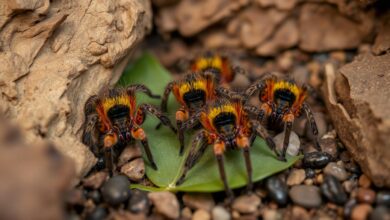Relationship between molting and behavioral changes in tarantulas
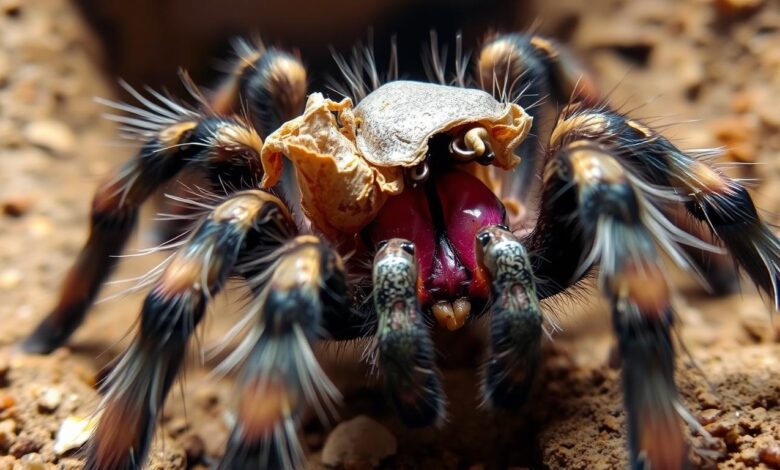
The tarantula’s exoskeleton is key to its survival and growth. It protects the tarantula but also restricts its body size. To grow, tarantulas must shed their exoskeleton, a process called molting. This change affects their behavior, making it important to study this relationship.
Molting is a dangerous time for tarantulas. Their new exoskeleton is soft and vulnerable. To protect themselves, tarantulas have developed unique behaviors. These include molting alone or together, seen in social groups.
We will explore how molting changes tarantula behavior. We’ll look at the molting process, different behaviors, and why understanding these is crucial. This knowledge helps us care for tarantulas better and appreciate their fascinating world.
Understanding Molting in Tarantulas
Molting, or ecdysis, is key for tarantulas and other arthropods. It’s when they shed their exoskeleton to grow. This lets them replace their old, stiff shell with a new, bigger one. It’s vital for their chelicerate life cycle and helps them grow and thrive.
Molting Process
The theraphosidae exoskeleton renewal starts with a new, soft exoskeleton forming under the old one. As it grows, the old spider exuvia structure slowly comes off. Finally, the tarantula emerges from its old skin in a dramatic event called molting or ecdysis.
Stages of Molting
The molting process in tarantulas has several stages:
- Pre-Molt: The tarantula eats less and moves less as it gets ready to molt.
- Ecdysis: The tarantula sheds its old exoskeleton, showing a soft, new one underneath.
- Post-Molt: The new exoskeleton hardens, and the tarantula’s appetite grows as it eats more.
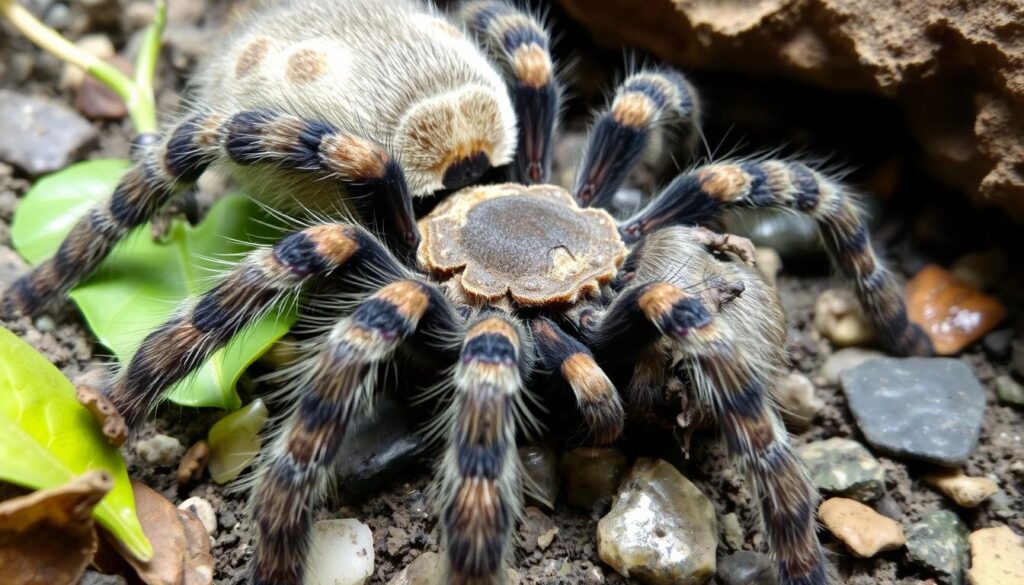
Behavioral Changes During Molting
As tarantulas get ready to molt, they show big changes in their behavior. These changes are key to the molting process in theraphosidae species.
Reduced Activity and Appetite
Before molting, tarantulas move less and eat less. Their tarantula behavior during molting shows in less movement. They save energy for shedding their skin. You might see your tarantula moving slower and not wanting to eat as much.
Defensive Posturing
As molting time comes, tarantulas change how they defend themselves. They might raise their front legs or use their hairs to scare off threats. This chelicerate molting-related activity changes helps them stay safe while they’re vulnerable.
Knowing about these arachnid pre-ecdysis behaviors helps you care for your tarantula better. By spotting the signs of molting, you can make sure they have a safe and healthy molt.
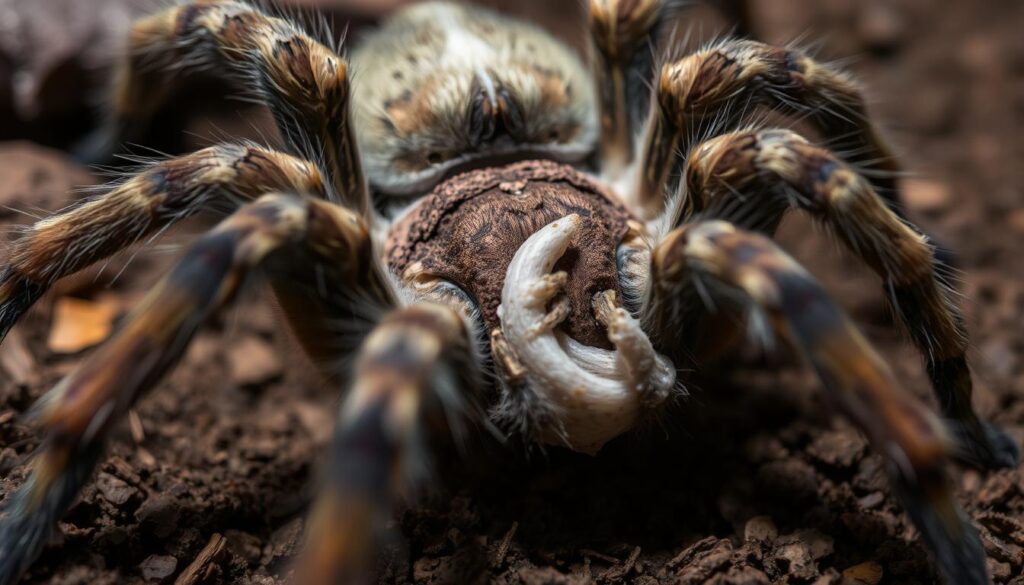
Tarantula Behavior Before Molting
Watching tarantulas before they molt can teach us a lot. This is called tarantula pre-molt behavior. As they get ready to molt, they show signs that tell us they are about to shed their skin.
One key sign is when they eat less and move less. They start to rest more and eat less. This helps them save energy for the big change ahead.
They also become more defensive. They stand up straight and show their mouthparts. This is to keep predators away while they are weak.
Knowing these signs helps us prepare for their molt. We can make sure they are safe and comfortable during this big change.
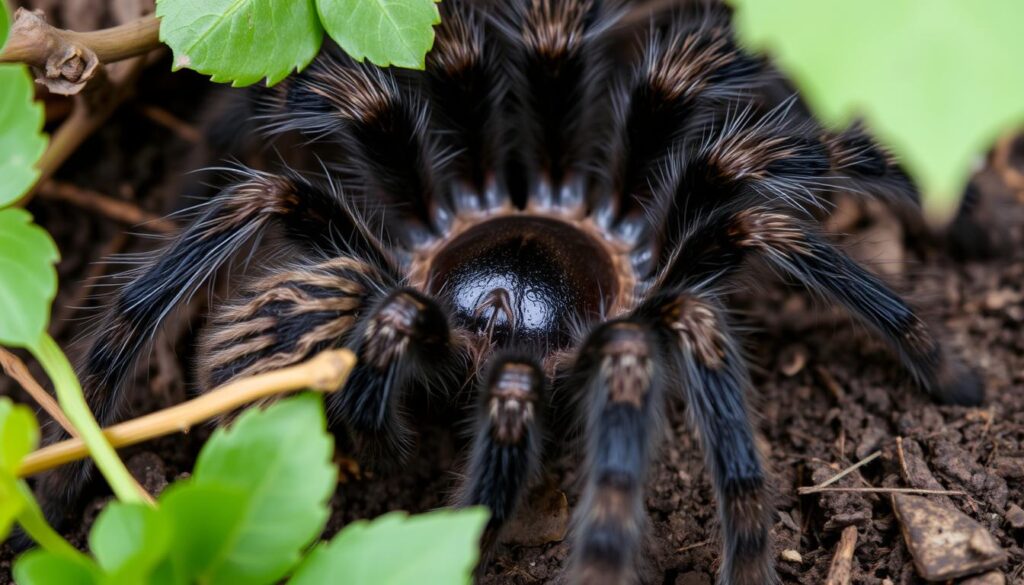
Tarantula Behavior After Molting
After molting, tarantulas show amazing changes. Their new exoskeletons harden, and their bodies heal. During this time, tarantula post-molt behavior includes a big appetite and more exploring.
Increased Appetite
Right after molting, tarantulas get very hungry. This is because molting is very energy-using. They need more food to fill up and grow their new, softer shells.
 Different defensive behaviors used by tarantulas in the wild and in captivity
Different defensive behaviors used by tarantulas in the wild and in captivity
Owners might see their tarantulas being more hungry and active. They want to eat a lot to help their bodies recover from chelicerate ecdysis recovery.
Exploratory Behavior
After shedding, tarantulas start to explore more. They move around and check out their surroundings. This helps them get used to their new size and find food and places to hide.
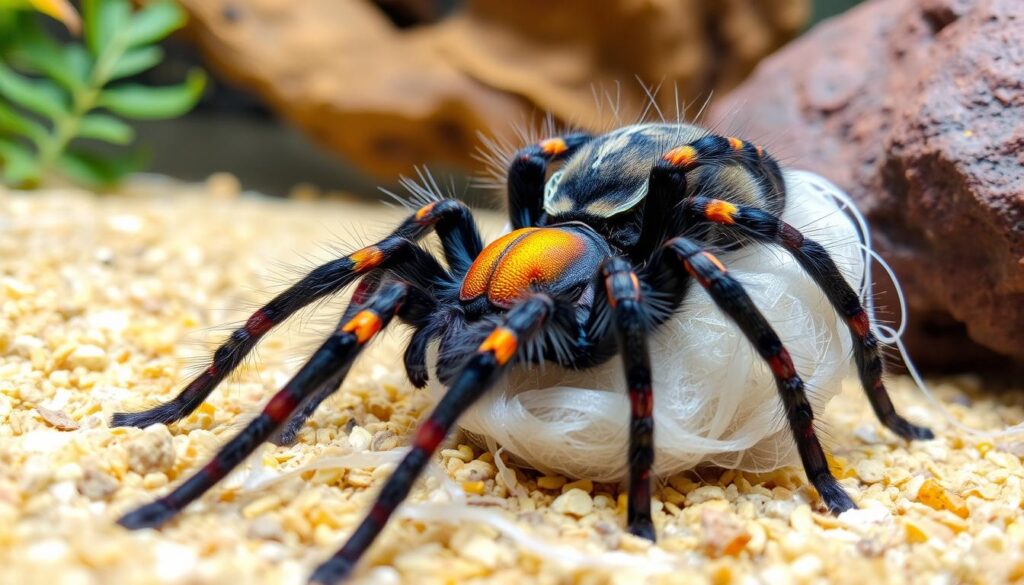
It’s important to know how tarantulas act after molting. This helps us take good care of them and make sure they recover well.
Importance of Undisturbed Molting
Keeping your tarantula’s molting process undisturbed is crucial for its health. The tarantula molting process disruption can cause big problems. It affects the arachnid ecdysis disturbance effects and the chelicerate exoskeleton renewal importance greatly.
Tarantulas are very sensitive when they molt. This is a key time for them to shed their old skin for a new, bigger one. Any disturbance can cause serious issues, like incomplete molts, injuries, or even death.
- Tarantulas need a quiet, undisturbed place to molt successfully.
- Sudden movements or contact can scare them and harm the molting process.
- Keeping the environment right, like temperature and humidity, is also key.
It’s important to respect your tarantula’s need for an undisturbed molting process. By creating the right conditions and avoiding disruptions, you help your tarantula stay healthy during this important time.
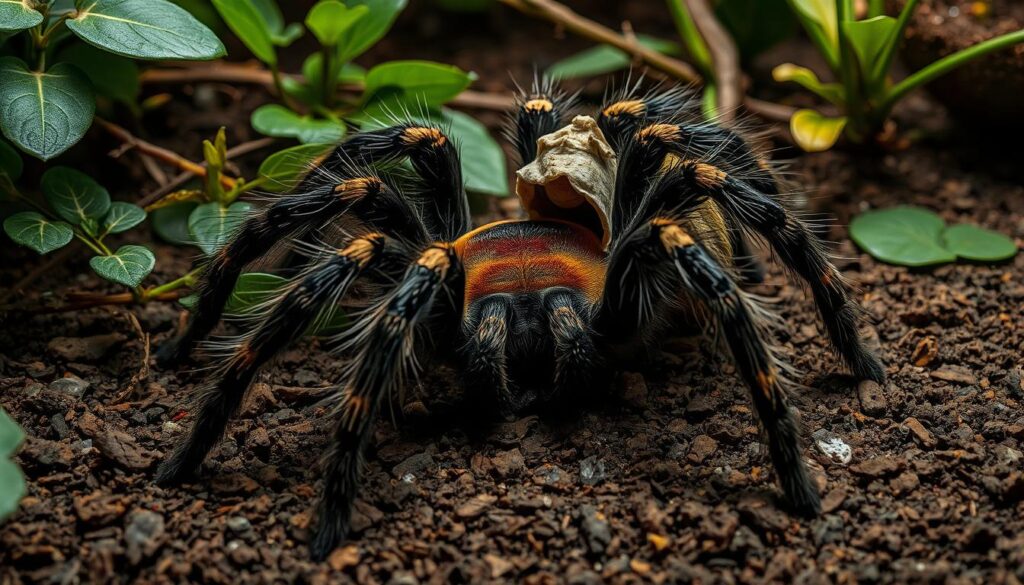
Knowing how vital undisturbed molting is, is key for tarantula lovers and owners. By focusing on your tarantula’s needs during this time, you support the chelicerate exoskeleton renewal importance and the theraphosidae molting sensitivity. This ensures your arachnid friend stays well for a long time.
Signs of an Impending Molt
As a tarantula owner, knowing the signs of an impending molt is key. Molting is when tarantulas shed their old skin to grow. By spotting the tarantula pre-molt physical signs and arachnid ecdysis behavioral precursors, you can meet your pet’s needs. This ensures a smooth molt.
Physical Indicators of Impending Molt
- Darkening or discoloration of the exoskeleton, especially around joints and legs, as a new one forms.
- A glazed or cloudy look in the tarantula’s eyes, known as “eye-bluing,” from new eye formation.
- Increased belly size and a swollen look, showing the new exoskeleton’s growth.
Behavioral Cues of Impending Molt
- Less activity and appetite, as the tarantula saves energy for molting.
- Defensive posturing, with raised front legs and exposed fangs, to ward off threats during vulnerability.
- More time in its hiding spot or burrow, preparing for the molt.
Watching for these chelicerate exoskeleton renewal indicators and theraphosidae molting cues helps you prepare for your tarantula’s molt. This ensures a stress-free and successful transition to its new skin.
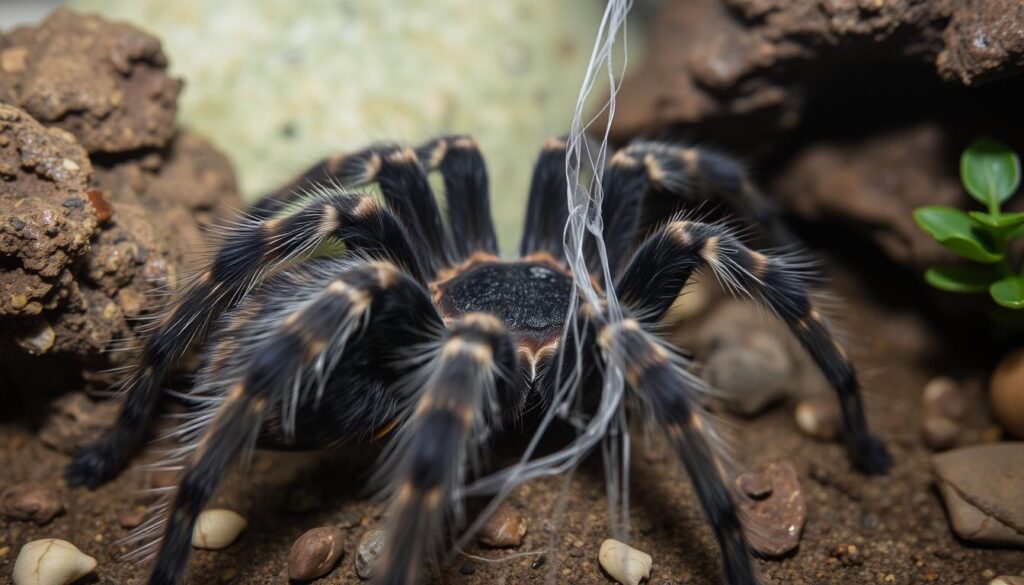
Relationship between molting and behavioral changes in tarantulas
The link between tarantula molting and behavior is truly captivating. As these arachnids shed their skin, their actions change in amazing ways. This change is a natural part of their life cycle.
Before they molt, tarantulas eat less and move less. This is because they are getting ready to shed their skin. After they shed, they start eating more and exploring again. This is because they are getting used to their new skin.
- Male tarantulas generally have fewer molts (2 to 8) compared to females, who have between 6 to 12 molts.
- Mygalomorph spiders, including tarantulas, may live up to 25 years, while primitive haplogyne spiders can live up to 10 years.
- Female tarantulas can live one or, at most, two years after producing the last egg sac.
Knowing how molting affects tarantulas is key to caring for them. By understanding their molting behavior, we can make sure they are comfortable and stress-free during this time.
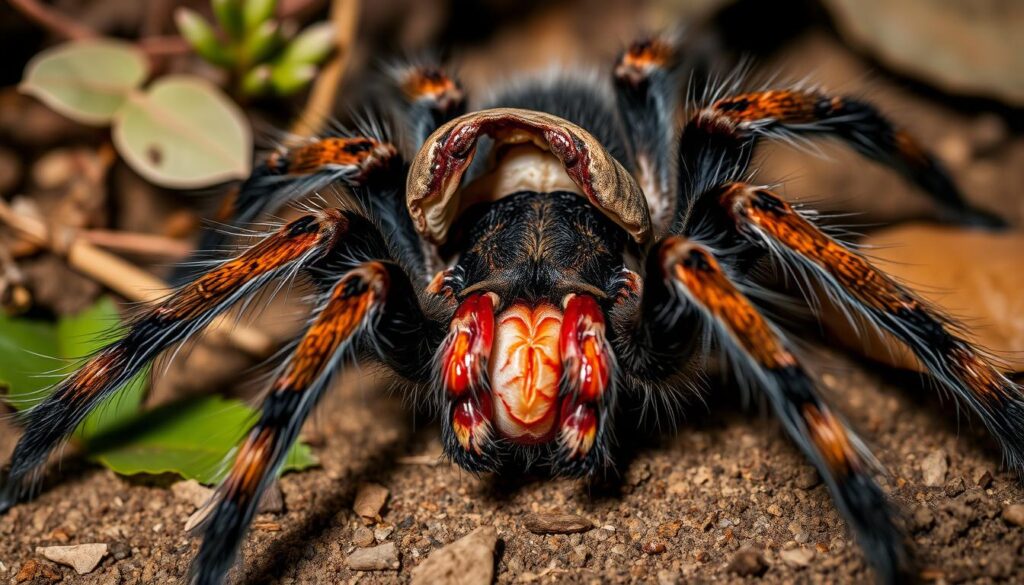
Whether you’re a tarantula expert or just interested, learning about their molting and behavior is rewarding. It shows how amazing these creatures are and how they adapt to their world.
Caring for Tarantulas During Molting
Molting is a key process for tarantulas. They shed their exoskeletons to grow. This stage needs special care and handling for a successful chelicerate exoskeleton renewal.
Environmental Conditions
The right theraphosidae molting habitat conditions are key during molting. The enclosure should have:
 Specific behaviors exhibited by tarantulas at night
Specific behaviors exhibited by tarantulas at night
- Humidity levels of 50-70% to keep the tarantula from drying out
- A temperature of 75-85°F (24-29°C) to aid in arachnid ecdysis
- Enough substrate depth, about 1.5 times the tarantula’s leg span, for burrowing
- Minimal disturbances to support the chelicerate exoskeleton renewal process
Handling Guidelines
It’s important to avoid handling molting tarantulas as much as possible. Their bodies are vulnerable, and handling can harm the new exoskeleton. If handling is needed, do it carefully and gently.
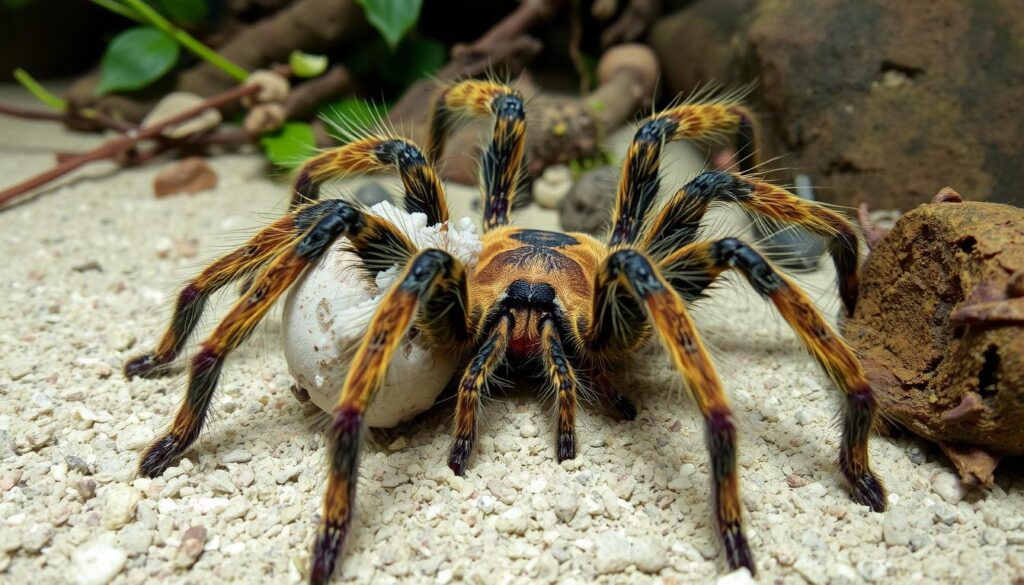
Knowing the environmental needs and handling tips helps care for your tarantula during arachnid ecdysis. This ensures a healthy chelicerate exoskeleton renewal.
Molting Challenges and Risks
Tarantulas face unique challenges during molting, a critical period in their life cycle. This process, known as ecdysis, can be difficult. It’s important for hobbyists and enthusiasts to know about tarantula molting difficulties, arachnid ecdysis risks, chelicerate exoskeleton renewal problems, and theraphosidae molting challenges.
One major concern is the exoskeleton getting stuck or not shedding properly, known as dysecdysis. This can cause serious issues, like not being able to come out of the old exoskeleton, deformities, and even death. It can also lead to losing limbs, affecting the tarantula’s health and mobility.
During molting, tarantulas are very vulnerable. Their new exoskeleton is soft, making them open to injuries, predation, and even being eaten by their own kind. It’s crucial to leave them alone during this time to avoid any harm.
| Molting Complication | Potential Risks | Preventive Measures |
|---|---|---|
| Dysecdysis (Improper molting) | Inability to fully emerge, deformities, and death | Maintain appropriate environmental conditions, avoid disturbances |
| Vulnerability during molting | Injuries, predation, and cannibalism | Isolate the tarantula, minimize external stimuli |
| Incomplete exoskeleton renewal | Stunted growth, compromised mobility, and health issues | Ensure proper nutrition and suitable habitat |
To overcome these molting challenges, one needs to understand tarantula biology, monitor them closely, and provide the best environment for molting. Knowing these risks and taking preventive steps can help ensure the health and long life of these fascinating creatures.
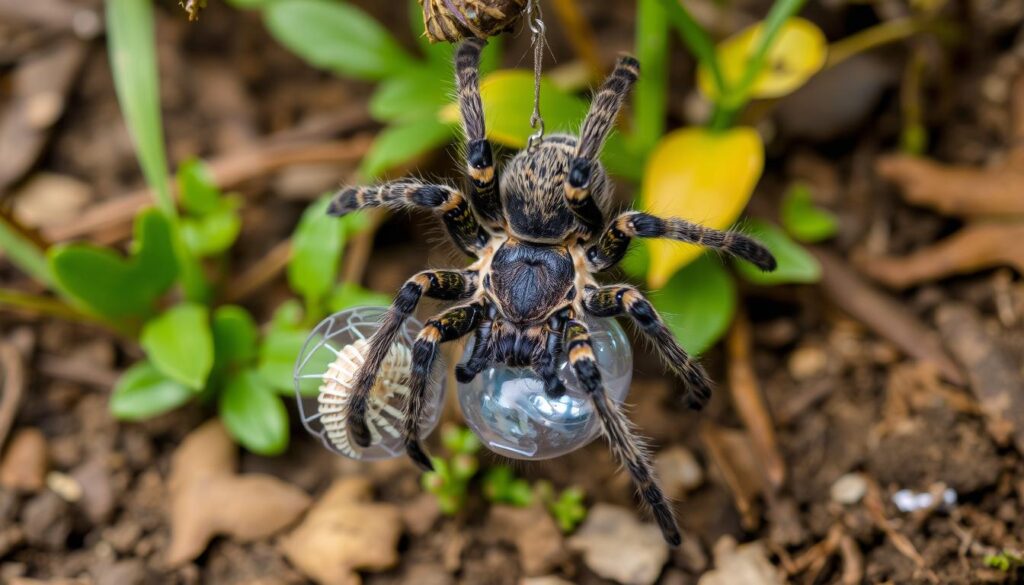
Tarantula Lifespan and Molting Frequency
Tarantulas are amazing arachnids with long lives and a special molting process. Their lifespan varies by species and gender. For example, female Green Bottle Blue Tarantulas can live up to 15 years, while males live 3 to 6 years. The Antilles Pink Toe Spider lives up to 12 years for females and 2 to 3 years for males, both in the wild and in captivity.
Molting is key to a tarantula’s life. They shed their skin to grow and fix any damage. How often they molt depends on their age, size, and species. Young tarantulas molt more often, while older ones might molt just once or twice a year.
| Tarantula Species | Female Lifespan | Male Lifespan | Molting Frequency |
|---|---|---|---|
| Green Bottle Blue Tarantula | Up to 15 years | 3 to 6 years | Frequent, especially during growth stages |
| Antilles Pink Toe Spider | Up to 12 years | 2 to 3 years | Regular, with older individuals molting less frequently |
It’s important for tarantula owners to know about molting. They need to create the right environment and care for their pets during this time. By understanding tarantulas’ lifespan and molting, owners can better care for their pets.
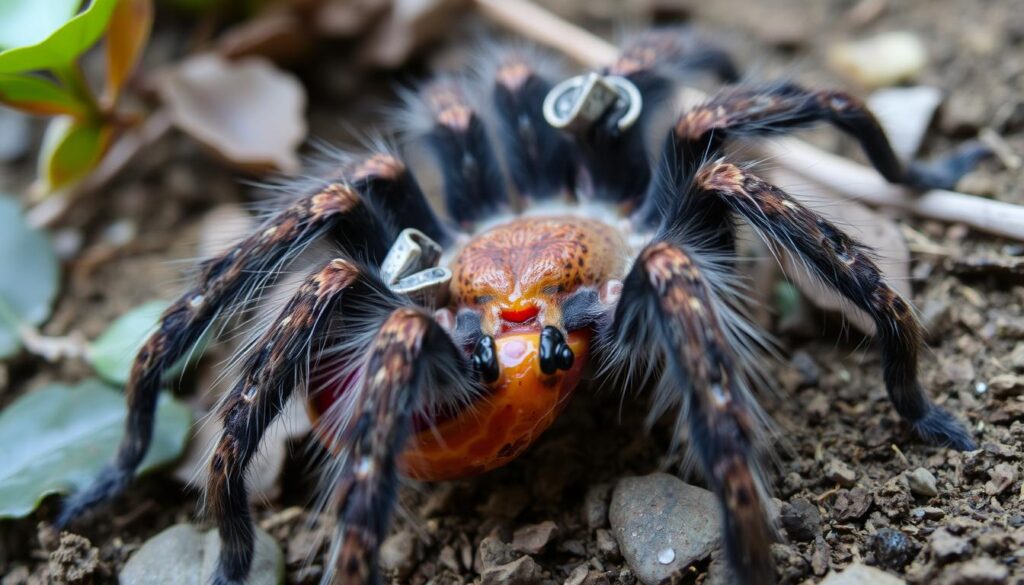
Species-Specific Molting Behaviors
Tarantulas all molt, but each species does it differently. Knowing these differences helps us understand their special needs. This is key for caring for theraphosidae species.
Arboreal vs. Terrestrial Species
Arboreal tarantulas, like those in the Poecilotheria genus, molt while hanging from ceilings or walls. They use silk to keep themselves safe. On the other hand, terrestrial tarantulas, such as Brachypelma, molt on the ground.
Old World vs. New World Tarantulas
The place where a tarantula comes from also affects how it molts. Old World tarantulas, from Asia and Africa, are more defensive during molting. They might act aggressively or use urticating hairs to scare off predators. New World tarantulas, from the Americas, are generally less defensive during this time.
| Characteristic | Arboreal Tarantulas | Terrestrial Tarantulas | Old World Tarantulas | New World Tarantulas |
|---|---|---|---|---|
| Molting Behavior | Suspend from ceiling/walls | Molt on substrate | More defensive behaviors | Less defensive behaviors |
| Geographic Origin | – | – | Asia, Africa | Americas |
| Example Genera | Poecilotheria | Brachypelma | Poecilotheria, Ceratogyrus | Brachypelma, Grammostola |
Knowing these differences helps us care for tarantulas better. It ensures they get the right environment and care during molting.
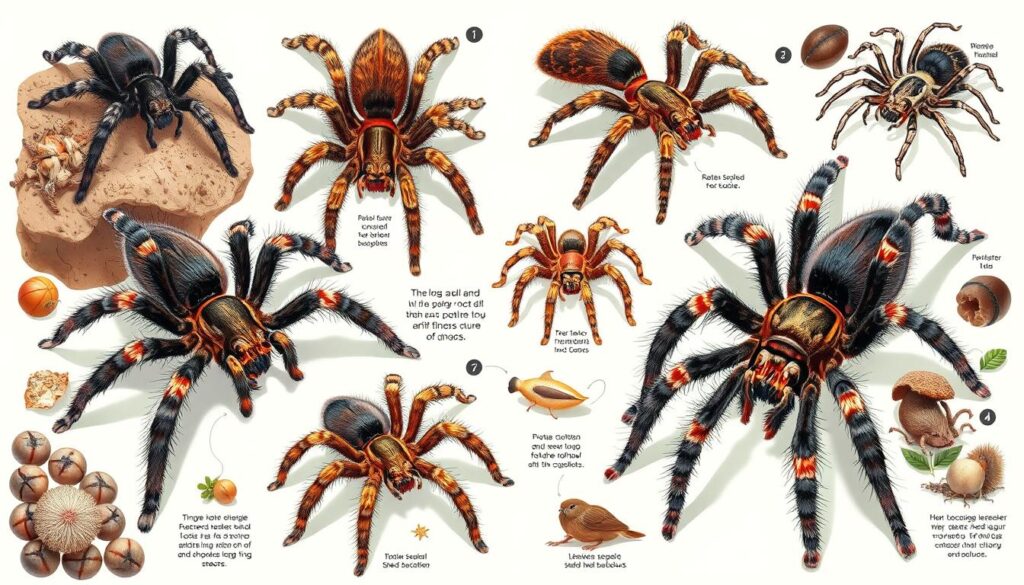
Observing Molting Tarantulas
Watching tarantulas molt is both fascinating and rewarding. The ecdysis, or exuviation, is a delicate process. It shows the amazing adaptations and behaviors of these creatures.
When observing tarantulas during molting, be patient and gentle. Avoid disturbing them, as this can cause problems. Create a special area for watching, with the right temperature and humidity.
 Degree of socialization and gregarious behavior in tarantulas
Degree of socialization and gregarious behavior in tarantulas
Keep an eye on the tarantula’s behavior and physical changes. Look for signs of pre-molt and the actual molting event. Seeing the tarantula come out of its old skin is amazing. It gives us a glimpse into their incredible adaptations.


